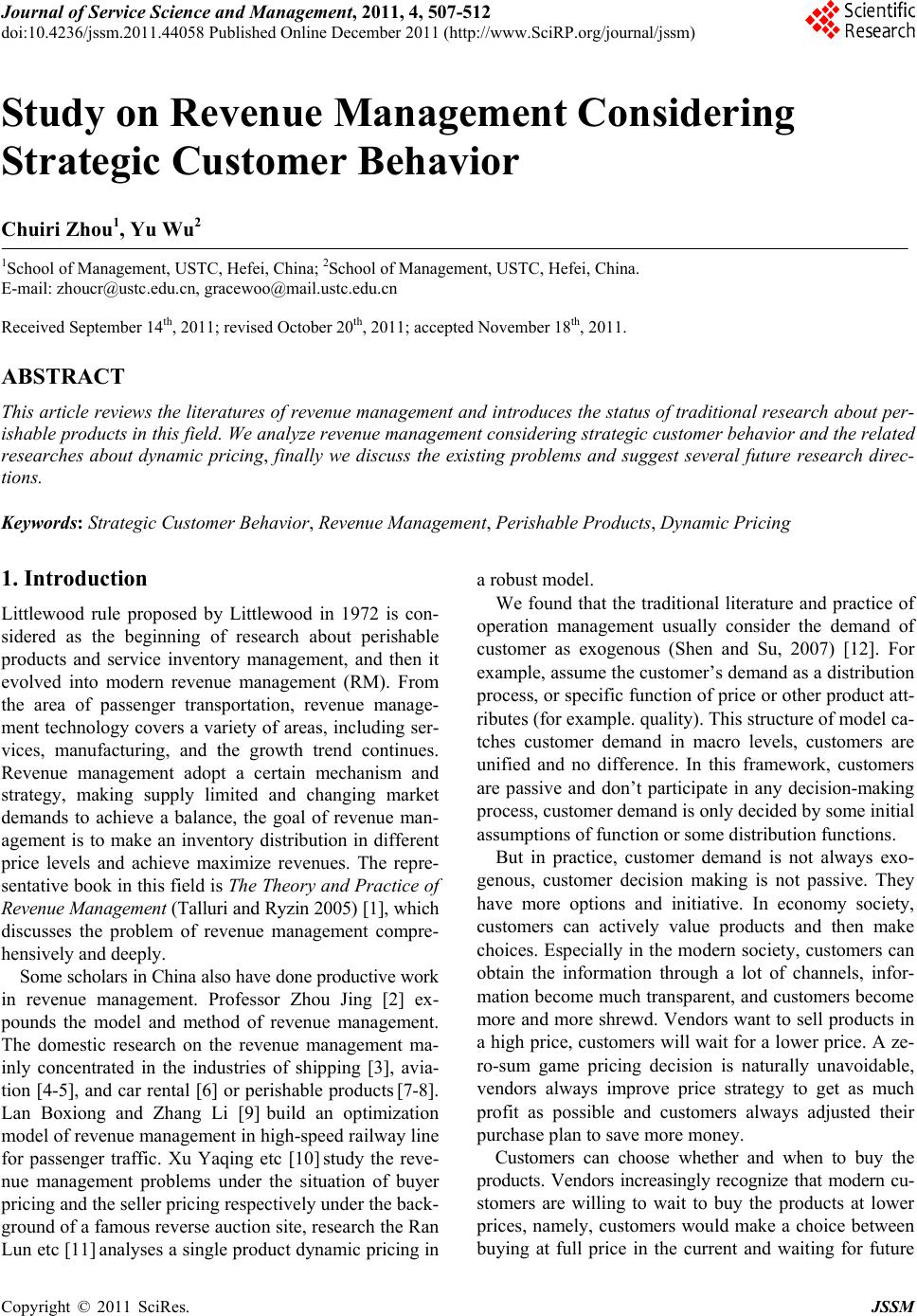 Journal of Service Science and Management, 2011, 4, 507-512 doi:10.4236/jssm.2011.44058 Published Online December 2011 (http://www.SciRP.org/journal/jssm) Copyright © 2011 SciRes. JSSM 507 Study on Revenue Management Considering Strategic Customer Behavior Chuiri Zhou1, Yu Wu2 1School of Management, USTC, Hefei, China; 2School of Management, USTC, Hefei, China. E-mail: zhoucr@ustc.edu.cn, gracewoo@mail.ustc.edu.cn Received September 14th, 2011; revised October 20th, 2011; accepted November 18th, 2011. ABSTRACT This article reviews the literatures of revenue management and introd uces the status of traditional research about per- ishable products in this field. We analyze revenue management considering strategic customer behavior and the related researches about dynamic pricing, finally we discuss the existing problems and suggest several future research direc- tions. Keywords: Strategic Customer Behavior, Revenue Management, Perishable Products, Dynamic Pricing 1. Introduction Littlewood rule proposed by Littlewood in 1972 is con- sidered as the beginning of research about perishable products and service inventory management, and then it evolved into modern revenue management (RM). From the area of passenger transportation, revenue manage- ment technology covers a variety of areas, including ser- vices, manufacturing, and the growth trend continues. Revenue management adopt a certain mechanism and strategy, making supply limited and changing market demands to achieve a balance, the goal of revenue man- agement is to make an inventory distribution in different price levels and achieve maximize revenues. The repre- sentative book in this field is The Theory and Practice of Revenue Management (Talluri and Ryzin 2005) [1], which discusses the problem of revenue management compre- hensively and deeply. Some scholars in China also have done productive work in revenue management. Professor Zhou Jing [2] ex- pounds the model and method of revenue management. The domestic research on the revenue management ma- inly concentrated in the industries of shipping [3], avia- tion [4-5], and car rental [6] or perishable products [7-8]. Lan Boxiong and Zhang Li [9] build an optimization model of revenue management in high-speed railway line for passenger traffic. Xu Yaqing etc [10] study the reve- nue management problems under the situation of buyer pricing and the seller pricing resp ectively und er th e back- ground of a famous reverse auction site, research the Ran Lun etc [11] analyses a single product dynamic pricing in a robust model. We found that the traditional literature and practice of operation management usually consider the demand of customer as exogenous (Shen and Su, 2007) [12]. For example, assume the customer’s demand as a distribution process, or specific function of price or other product att- ributes (for example. quality). This structure of model ca- tches customer demand in macro levels, customers are unified and no difference. In this framework, customers are passive and don’t participate in any decision-making process, customer demand is only decided by some initial assumptions of function or some distribution functions. But in practice, customer demand is not always exo- genous, customer decision making is not passive. They have more options and initiative. In economy society, customers can actively value products and then make choices. Especially in the modern society, customers can obtain the information through a lot of channels, infor- mation b ecome mu ch tran sparen t, and cu stomers b ecome more and more shrewd. Vendors want to sell products in a high price, customers will wait for a lower price. A ze- ro-sum game pricing decision is naturally unavoidable, vendors always improve price strategy to get as much profit as possible and customers always adjusted their purchase plan to save more money. Customers can choose whether and when to buy the products. Vendors increasingly recognize that modern cu- stomers are willing to wait to buy the products at lower prices, namely, customers would make a choice between buying at full price in the current and waiting for future 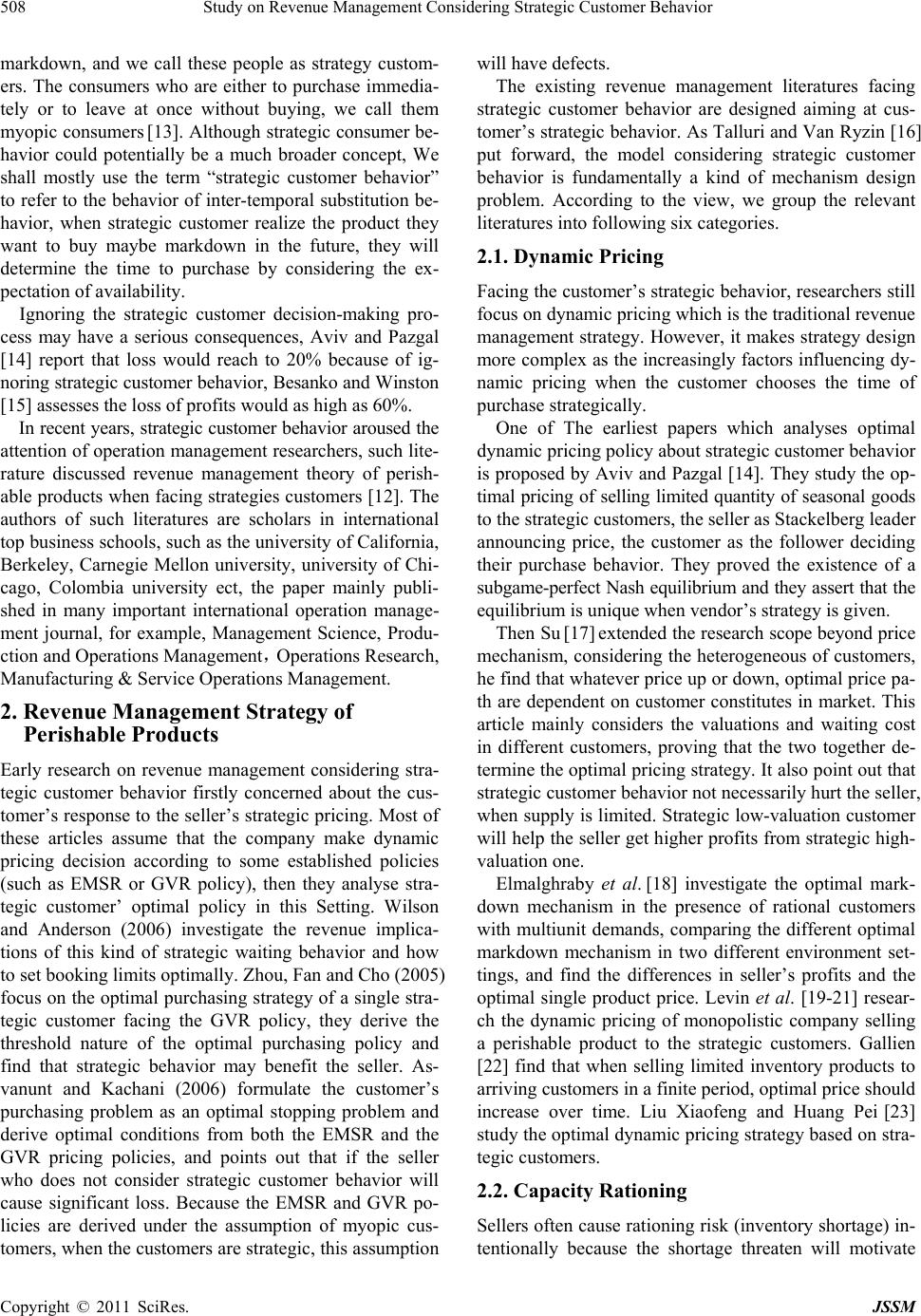 Study on Revenue Management Considering Strategic Customer Behavior 508 markdown, and we call these people as strategy custom- ers. The consumers who are either to purchase immedia- tely or to leave at once without buying, we call them myopic consumers [13]. Although str ategic consumer be- havior could potentially be a much broader concept, We shall mostly use the term “strategic customer behavior” to refer to the behavior of inter-temporal substitution be- havior, when strategic customer realize the product they want to buy maybe markdown in the future, they will determine the time to purchase by considering the ex- pectation of availability. Ignoring the strategic customer decision-making pro- cess may have a serious consequences, Aviv and Pazgal [14] report that loss would reach to 20% because of ig- noring strategic customer behavior, Besanko and Winston [15] assesses the loss of profits would as high as 60%. In recent years, strategic customer behavior aroused the attention of operation manage ment researchers, such lite- rature discussed revenue management theory of perish- able products when facing strategies customers [12]. The authors of such literatures are scholars in international top business schools, such as the university of California, Berkeley, Carnegie Mellon university, university of Chi- cago, Colombia university ect, the paper mainly publi- shed in many important international operation manage- ment journal, for example, Management Science, Produ- ction and Operations Management,Operations Research, Manufacturing & Service Operations Management. 2. Revenue Management Strategy of Perishable Products Early research on revenue management considering stra- tegic customer behavior firstly concerned about the cus- tomer’s response to the seller’s strateg ic pricing. Most of these articles assume that the company make dynamic pricing decision according to some established policies (such as EMSR or GVR policy), then they analyse stra- tegic customer’ optimal policy in this Setting. Wilson and Anderson (2006) investigate the revenue implica- tions of this kind of strategic waiting behavior and how to set booking limits optimally. Zhou, Fan and Cho (2005) focus on the optimal purchasing strategy of a single stra- tegic customer facing the GVR policy, they derive the threshold nature of the optimal purchasing policy and find that strategic behavior may benefit the seller. As- vanunt and Kachani (2006) formulate the customer’s purchasing problem as an optimal stopping problem and derive optimal conditions from both the EMSR and the GVR pricing policies, and points out that if the seller who does not consider strategic customer behavior will cause significant loss. Because the EMSR and GVR po- licies are derived under the assumption of myopic cus- tomers, when the customers are strategic, this assumption will have defects. The existing revenue management literatures facing strategic customer behavior are designed aiming at cus- tomer’s strategic behavior. As Talluri and Van Ryzin [16] put forward, the model considering strategic customer behavior is fundamentally a kind of mechanism design problem. According to the view, we group the relevant literatures into following six categories. 2.1. Dynamic Pricing Facing the customer’s strategic behavior, researchers still focus on dynamic pricing which is th e traditio n al revenue management strategy. However, it makes strategy design more complex as the increasingly factors influencing dy- namic pricing when the customer chooses the time of purchase strategically. One of The earliest papers which analyses optimal dynamic pricing policy about strategic customer behavior is proposed by Aviv and Pazgal [14]. They study the op- timal pricing of selling limited quantity of seasonal goods to the strategic customers, the seller as Stackelberg leader announcing price, the customer as the follower deciding their purchase behavior. They proved the existence of a subgame-perfect Nash equilibrium and they assert that the equilibrium is unique when vendor’s strategy is given. Then Su [17] extended the research scope beyond price mechanism, considering the heterogeneous of customers, he find that whatever price up or down, optimal price pa- th are dependent on customer constitutes in market. This article mainly considers the valuations and waiting cost in different customers, proving that the two together de- termine the optimal pricing strategy. It also po int out that strategic customer behavior not necessarily hurt the seller, when supply is limited. Strateg ic low-valuation customer will help the seller get higher profits from strategic high- valuation one. Elmalghraby et al. [18] investigate the optimal mark- down mechanism in the presence of rational customers with multiunit demands, comparing the different optimal markdown mechanism in two different environment set- tings, and find the differences in seller’s profits and the optimal single product price. Levin et al. [19-21] resear- ch the dynamic pricing of monopolistic company selling a perishable product to the strategic customers. Gallien [22] find that when selling limited inventory products to arriving customers in a finite period, optimal price should increase over time. Liu Xiaofeng and Huang Pei [23] study the optimal dynamic pricing strategy based on stra- tegic customers. 2.2. Capacity Rationing Sellers often cause rationing risk (inventory shortag e) in- tentionally because the shortage threaten will motivate Copyright © 2011 SciRes. JSSM  Study on Revenue Management Considering Strategic Customer Behavior509 customers early buying in a high price, we call this strat- egy as capacity rationing. Liu and Van Ryzin [24] study a two stage capacity control model. The price in the second stage is lower than that in the first stage, the customers have different valuations to products, and they know the product price path and full rate in each stage. Through the capacity rationing, vendo rs can control fu ll rate, so as to control the customer’s rationing risk. Liu and Van Ryzin analyse and find that the option of capacity which can bring seller largest benefit, and they also find th at the optimal capacity quantity is influen ced between the price changing range and the customer’s risk aversion degree level. Zhang and Cooper [25] consider a two stage framewo- rk in which capacity rationing is observable, and prove the advantage of capacity rationing. It indicates that the seller may limit quantities in the second stage when company sells a single product through a two stage fra- mework. Given a fixed inventory, the impact of rationing is different when price is flexible or be fixed at a certain level. For a fixed price, restricting availability at clear- ance price can be advantageous to the firm even when there is leftover inventory that will o therwise be wasted. Su and Zhang [26] study how the availability of produ- cts attracts the consumers, they put forward two strate- gies to improve the seller’s profits. One is to use com- mitment and the other one is to use availability guaran- tees. They also prove that when seller uses a combination of these two strategies can achieve optimal results. But the article assumes that the consumers are perfect ra- tional and they form rational expectations and make op- timal decisions with perfect accuracy. It is actually not inconsistent with the reality, and the article considers that the consumers should be regarded as limited rational decision makers in researc hes in the future . 2.3. Posterior Price Matching (Posterior PM) Posterior PM policy is a market strategy which provided by seller. If the seller decreases the price within a spe- cific period, the customer will be promised to get the price lower than the former price. The posterior PM po- licy can effectively change customer’s buying behavior, enticing customers to buy early. Levin et al. [19] analyses revenue management of a monopoly sellers who provide posterior price matching policy, and probes in to the optimal strategy of price path and price matching. Bu t they don’t consider the strategic customer behavior. Later Xu [27] study the posterior PM policy consider- ing the strategic customers, discusses the optimum design of compensation rate. But Xu assume that the quantity o f customer is fixed, it has not taken demand uncertainty and inventory investment decisions into account. Assuming that ve ndors cannot guarantee the price path, but may practice posterior price matching strategy, Lai et al. [28] study the impact of posterior PM policy on cus- tomer purchase behavior, vendor’s price, inventory stra- tegy and expected profit. They find that the PM policy reduces the strategic customer’s incentive of waiting, and allows sellers to raise prices in regular selling season. When the proportion of strategic customer is not small and product evaluation is not very low or very high over time, PM policy can greatly increase vendor’s profits. The study found that this policy is insen sitive to the pro- portion of consu mers who claim the refund. This implies that a Pareto improvement for both the seller’s and the custom er ’s p ayoff is possible unde r the PM polic y. 2.4. Advance Selling Sellers can divide sale period into two stages, advance selling period and spot markets period. The price at two stages are different and the customers can make choice when to buy. Tang et al. [29] discusses the advance selling strategy. At first, demand is uncertainty, retailer develops a pro- gram called an “advance booking discount” (ABD) pro- gram that entices customers to commit to their order at a discount price prior to the selling season. It improves the forecast and enables the retailer to place a more accurate order at the beginning of the selling season, which in turn reduces over-stock and under-stock costs and improves customer service levels. The article evaluates the benefits of the ABD program and characterizes the optimal dis- count price that maximizes the retailer’s expected profit. But they did not consider customer strategy behavior. Seller needs not only select price but also make sure providing how many products for advance selling when facing the strategic customers. Yu et al. [30] consider a seller with limited capacity who offer a single product to customers at two stages. They find that the benefit of ad- vance selling depend on factors such as unit cost, capaci- ty level, advance and spot market size, and customer be- havior. Particularly, they analyze when the seller should order advance selling and whether advance price adds a premium or a discount to the spot price, especially as a function of available capacity and customer behavior. 2.5. Display Formats An important factor should to be considered by strategic customers in the purchase decisions is the availability of product in the future, and the sales mechanism will in- fluence the customer’s estimate of product availability. Yin et al. [31] consider a retailer who sells a limited in- ventory of a product over a finite selling season, using one of two inventory display formats: Display All (DA) and Display One (DO). Under the DA format, the retailer Copyright © 2011 SciRes. JSSM 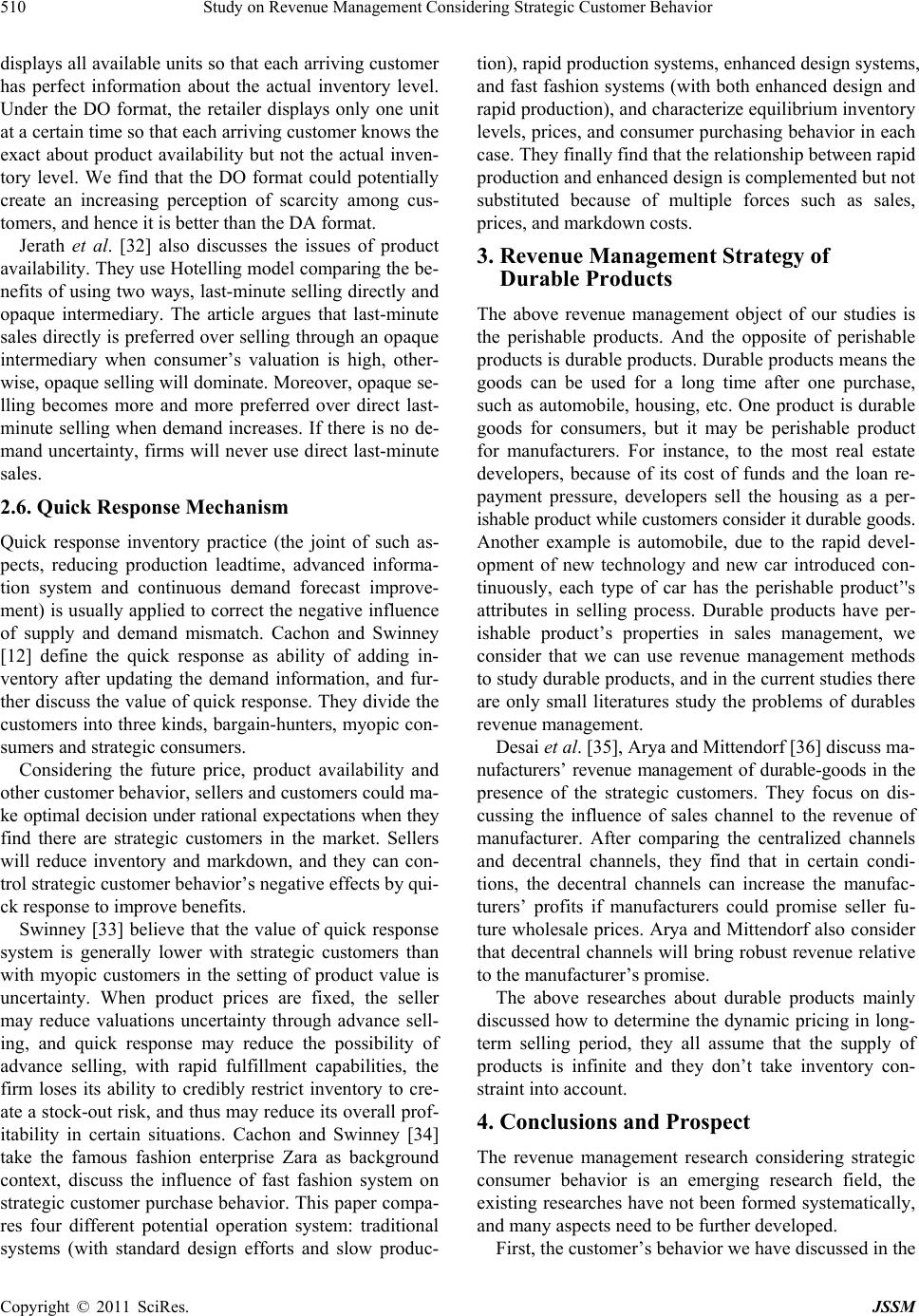 Study on Revenue Management Considering Strategic Customer Behavior 510 displays all available units so that each arriving customer has perfect information about the actual inventory level. Under the DO format, the retailer displays only one unit at a certain time so that each arriving customer knows the exact about product availability but not the actual inven- tory level. We find that the DO format could potentially create an increasing perception of scarcity among cus- tomers, and hence it is better than the DA format. Jerath et al. [32] also discusses the issues of product availability. They use Hotelling model comparing the be- nefits of using two ways, last-minute selling directly and opaque intermediary. The article argues that last-minute sales directly is preferred over selling through an opaque intermediary when consumer’s valuation is high, other- wise, opaque selling will d ominate. Moreover, opaque se- lling becomes more and more preferred over direct last- minute selling when demand increases. If there is no de- mand uncertainty, firms will never use direct last-minute sales. 2.6. Quick Response Mechanism Quick response inventory practice (the joint of such as- pects, reducing production leadtime, advanced informa- tion system and continuous demand forecast improve- ment) is usually applied to correct the negative influence of supply and demand mismatch. Cachon and Swinney [12] define the quick response as ability of adding in- ventory after updating the demand information, and fur- ther discuss the value of quick response. They divide the customers into three kinds, bargain-hunters, myopic con- sumers and strategic consumers. Considering the future price, product availability and other customer behavior, sellers and customers could ma- ke optimal decision under rational expectations when they find there are strategic customers in the market. Sellers will reduce inventory and markdown, and they can con- trol strategic customer behavior’s negative effects by qui- ck response to impro ve b en efits. Swinney [33] believe that the value of quick response system is generally lower with strategic customers than with myopic customers in the setting of product value is uncertainty. When product prices are fixed, the seller may reduce valuations uncertainty through advance sell- ing, and quick response may reduce the possibility of advance selling, with rapid fulfillment capabilities, the firm loses its ability to credibly restrict inventory to cre- ate a stock-out risk, and thus may reduce its overall prof- itability in certain situations. Cachon and Swinney [34] take the famous fashion enterprise Zara as background context, discuss the influence of fast fashion system on strategic customer purchase behavior. This paper compa- res four different potential operation system: traditional systems (with standard design efforts and slow produc- tion), rapid production systems, enhanced design systems, and fast fashion systems (with both enhanced design and rapid production), and ch aracterize equilibrium in ventory levels, prices, and consumer purchasing behavior in each case. They finally find that the relationship between rapid production and enhanced design is complemented but not substituted because of multiple forces such as sales, prices, and markdown costs. 3. Revenue Management Strategy of Durable Products The above revenue management object of our studies is the perishable products. And the opposite of perishable products is durable produ cts. Durable products means the goods can be used for a long time after one purchase, such as automobile, housing, etc. One product is durable goods for consumers, but it may be perishable product for manufacturers. For instance, to the most real estate developers, because of its cost of funds and the loan re- payment pressure, developers sell the housing as a per- ishable product while customers consider it durable goods. Another example is automobile, due to the rapid devel- opment of new technology and new car introduced con- tinuously, each type of car has the perishable product’'s attributes in selling process. Durable products have per- ishable product’s properties in sales management, we consider that we can use revenue management methods to study durable products, and in the current studies ther e are only small literatures study the problems of durables revenue management. Desai et al. [35], Arya and Mittendorf [36] discuss ma- nufacturers’ revenue management of durable-goods in the presence of the strategic customers. They focus on dis- cussing the influence of sales channel to the revenue of manufacturer. After comparing the centralized channels and decentral channels, they find that in certain condi- tions, the decentral channels can increase the manufac- turers’ profits if manufacturers could promise seller fu- ture wholesale prices. Arya and Mittendorf also consider that decentral channels will bring robust revenue relative to the manufacturer’s promise. The above researches about durable products mainly discussed how to determine the dynamic pricing in long- term selling period, they all assume that the supply of products is infinite and they don’t take inventory con- straint into account. 4. Conclusions and Prospect The revenue management research considering strategic consumer behavior is an emerging research field, the existing researches have not been formed systematically, and many aspects need to be further developed. First, the customer’s behavior we have discussed in the Copyright © 2011 SciRes. JSSM 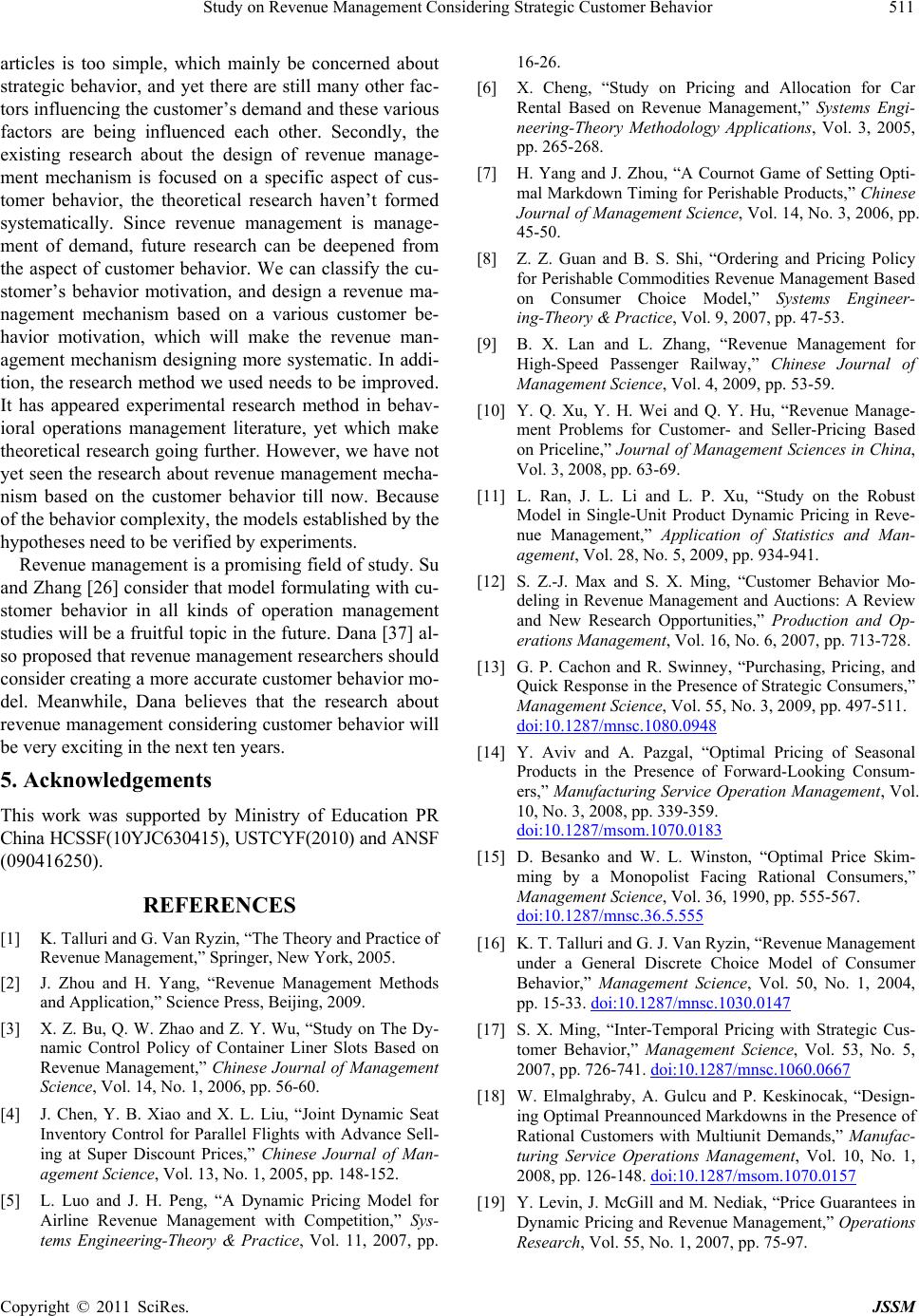 Study on Revenue Management Considering Strategic Customer Behavior511 articles is too simple, which mainly be concerned about strategic behavior, and yet there are still many other fac- tors influencing the customer’s demand and these various factors are being influenced each other. Secondly, the existing research about the design of revenue manage- ment mechanism is focused on a specific aspect of cus- tomer behavior, the theoretical research haven’t formed systematically. Since revenue management is manage- ment of demand, future research can be deepened from the aspect of customer behavior. We can classify the cu- stomer’s behavior motivation, and design a revenue ma- nagement mechanism based on a various customer be- havior motivation, which will make the revenue man- agement mechanism designing more systematic. In addi- tion, the research method we used needs to be improved. It has appeared experimental research method in behav- ioral operations management literature, yet which make theoretical research going further. However, we have not yet seen the research about revenue management mecha- nism based on the customer behavior till now. Because of the behavior complexity, the models established by the hypotheses need to be verified by experiments. Revenue management is a promising field of study. Su and Zhang [26] consider that model formulating with cu- stomer behavior in all kinds of operation management studies will be a fruitful topic in the future. Dana [37] al- so proposed that revenue management researchers should consider creating a more accurate customer behavior mo- del. Meanwhile, Dana believes that the research about revenue management considering customer behavior will be very exciting in the next ten years. 5. Acknowledgements This work was supported by Ministry of Education PR China HCSSF(10YJC630415), USTCYF(2010) and ANSF (090416250). REFERENCES [1] K. Talluri and G. Van Ryzin, “The Theory and Practice of Revenue Management,” Springer, New York, 2005. [2] J. Zhou and H. Yang, “Revenue Management Methods and Application,” Science Press, Beijing, 2009. [3] X. Z. Bu, Q. W. Zhao and Z. Y. Wu, “Study on The Dy- namic Control Policy of Container Liner Slots Based on Revenue Management,” Chinese Journal of Management Science, Vol. 14, No. 1, 2006, pp. 56-60. [4] J. Chen, Y. B. Xiao and X. L. Liu, “Joint Dynamic Seat Inventory Control for Parallel Flights with Advance Sell- ing at Super Discount Prices,” Chinese Journal of Man- agement Science, Vol. 13, No. 1, 2005, pp. 148-152. [5] L. Luo and J. H. Peng, “A Dynamic Pricing Model for Airline Revenue Management with Competition,” Sys- tems Engineering-Theory & Practice, Vol. 11, 2007, pp. 16-26. [6] X. Cheng, “Study on Pricing and Allocation for Car Rental Based on Revenue Management,” Systems Engi- neering-Theory Methodology Applications, Vol. 3, 2005, pp. 265-268. [7] H. Yang and J. Zhou, “A Cournot Game of Setting Opti- mal Markdown Timing for Perishable Products,” Chinese Journal of Management Science, Vol. 14, No. 3, 2006, pp. 45-50. [8] Z. Z. Guan and B. S. Shi, “Ordering and Pricing Policy for Perishable Commodities Revenue Management Based on Consumer Choice Model,” Systems Engineer- ing-Theory & Practice, Vol. 9, 2007, pp. 47-53. [9] B. X. Lan and L. Zhang, “Revenue Management for High-Speed Passenger Railway,” Chinese Journal of Management Science, Vol. 4, 2009, pp. 53-59. [10] Y. Q. Xu, Y. H. Wei and Q. Y. Hu, “Revenue Manage- ment Problems for Customer- and Seller-Pricing Based on Priceline,” Journal of Management Sciences in China, Vol. 3, 2008, pp. 63-69. [11] L. Ran, J. L. Li and L. P. Xu, “Study on the Robust Model in Single-Unit Product Dynamic Pricing in Reve- nue Management,” Application of Statistics and Man- agement, Vol. 28, No. 5, 2009, pp. 934-941. [12] S. Z.-J. Max and S. X. Ming, “Customer Behavior Mo- deling in Revenue Management and Auctions: A Review and New Research Opportunities,” Production and Op- erations Management, Vol. 16, No. 6, 2007, pp. 713-728. [13] G. P. Cachon and R. Swinney, “Purchasing, Pricing, and Quick Response in the Presence of Strategic Consumers,” Management Science, Vol. 55, No. 3, 2009, pp. 497-511. doi:10.1287/mnsc.1080.0948 [14] Y. Aviv and A. Pazgal, “Optimal Pricing of Seasonal Products in the Presence of Forward-Looking Consum- ers,” Manufacturing Service Operation Management, Vol. 10, No. 3, 2008, pp. 339-359. doi:10.1287/msom.1070.0183 [15] D. Besanko and W. L. Winston, “Optimal Price Skim- ming by a Monopolist Facing Rational Consumers,” Management Science, Vol. 36, 1990, pp. 555-567. doi:10.1287/mnsc.36.5.555 [16] K. T. Tal luri and G. J. Van Ryzin, “Reve n ue Manage ment under a General Discrete Choice Model of Consumer Behavior,” Management Science, Vol. 50, No. 1, 2004, pp. 15-33. doi:10.1287/mnsc.1030.0147 [17] S. X. Ming, “Inter-Temporal Pricing with Strategic Cus- tomer Behavior,” Management Science, Vol. 53, No. 5, 2007, pp. 726-741. doi:10.1287/mnsc.1060.0667 [18] W. Elmalghraby, A. Gulcu and P. Keskinocak, “Design- ing Optimal Preannounced Markdowns in the Presence of Rational Customers with Multiunit Demands,” Manufac- turing Service Operations Management, Vol. 10, No. 1, 2008, pp. 126-148. doi:10.1287/msom.1070.0157 [19] Y. Levin, J. McGill and M. Nediak, “Price Guarantees in Dynamic Pricing and Revenue Management,” Operations Research, Vol. 55, No. 1, 2007, pp. 75-97. Copyright © 2011 SciRes. JSSM 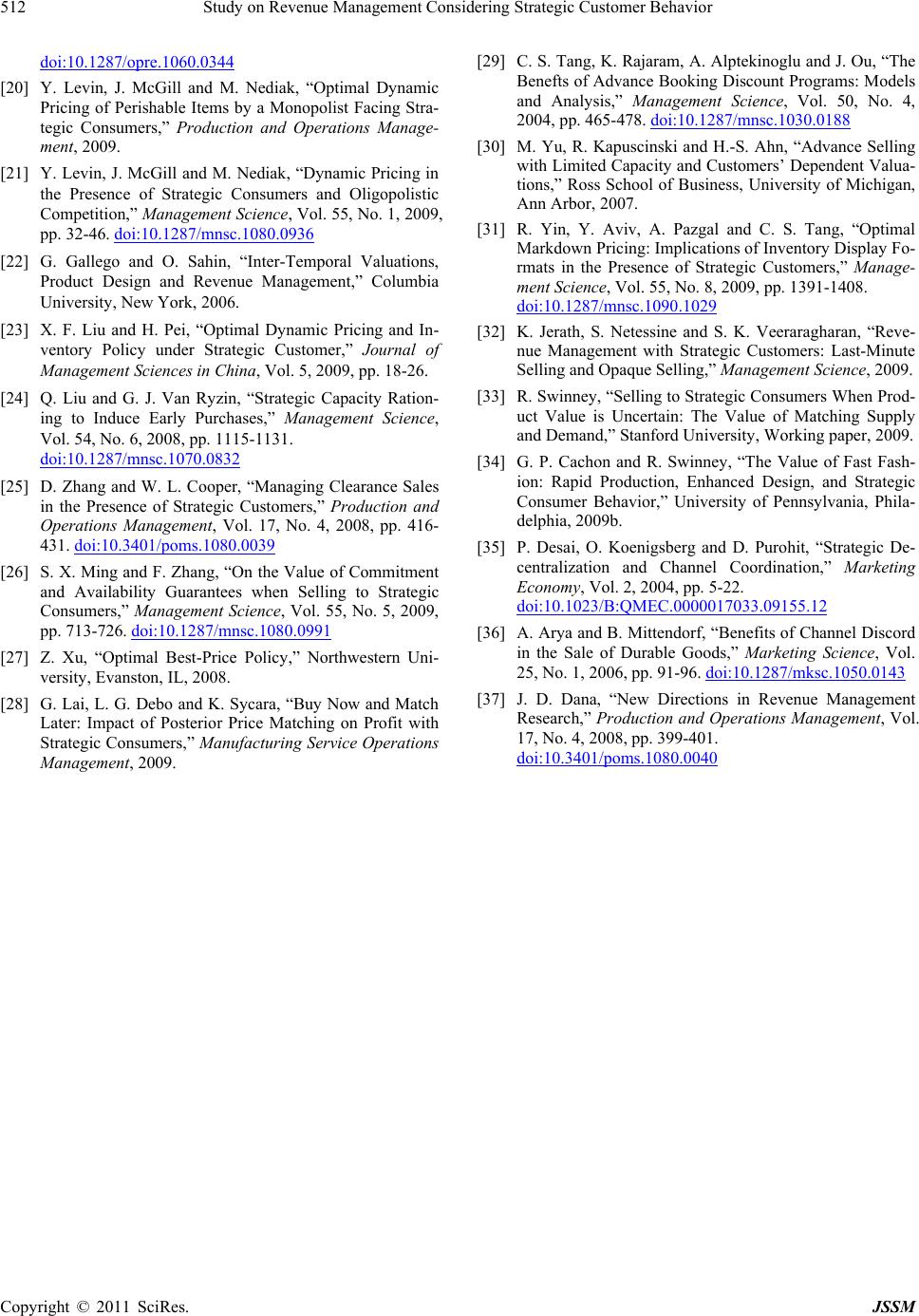 Study on Revenue Management Considering Strategic Customer Behavior Copyright © 2011 SciRes. JSSM 512 doi:10.1287/opre.1060.0344 [20] Y. Levin, J. McGill and M. Nediak, “Optimal Dynamic Pricing of Perishable Items by a Monopolist Facing Stra- tegic Consumers,” Production and Operations Manage- ment, 2009. [21] Y. Levin, J. McGill and M. Nediak, “Dynamic Pricing in the Presence of Strategic Consumers and Oligopolistic Competition,” Management Science, Vol. 55, No. 1, 2009, pp. 32-46. doi:10.1287/mnsc.1080.0936 [22] G. Gallego and O. Sahin, “Inter-Temporal Valuations, Product Design and Revenue Management,” Columbia University, New York, 2006. [23] X. F. Liu and H. Pei, “Optimal Dynamic Pricing and In- ventory Policy under Strategic Customer,” Journal of Management Sciences in China, Vol. 5, 2009, pp. 18-26. [24] Q. Liu and G. J. Van Ryzin, “Strategic Capacity Ration- ing to Induce Early Purchases,” Management Science, Vol. 54, No. 6, 2008, pp. 1115-1131. doi:10.1287/mnsc.1070.0832 [25] D. Zhang and W. L. Cooper, “Managing Clearance Sales in the Presence of Strategic Customers,” Production and Operations Management, Vol. 17, No. 4, 2008, pp. 416- 431. doi:10.3401/poms.1080.0039 [26] S. X. Ming and F. Zhang, “On the Value of Commitment and Availability Guarantees when Selling to Strategic Consumers,” Management Science, Vol. 55, No. 5, 2009, pp. 713-726. doi:10.1287/mnsc.1080.0991 [27] Z. Xu, “Optimal Best-Price Policy,” Northwestern Uni- versity, Evanston, IL, 2008. [28] G. Lai, L. G. Debo and K. Syca ra, “Buy Now and Match Later: Impact of Posterior Price Matching on Profit with Strategic Consumers,” Manufacturing Service Operations Management, 2009. [29] C. S. Tang, K. Rajaram, A. Alptekinoglu and J. Ou, “The Benefts of Advance Booking Discount Programs: Models and Analysis,” Management Science, Vol. 50, No. 4, 2004, pp. 465-478. doi:10.1287/mnsc.1030.0188 [30] M. Yu, R. Kapuscinski and H.-S. Ahn, “Advance Selling with Limi ted Capacity and Customers’ De pendent Val ua- tions,” Ross School of Business, University of Michigan, Ann Arbor, 2007. [31] R. Yin, Y. Aviv, A. Pazgal and C. S. Tang, “Optimal Markdown Pricing: Implications of Inventory Display Fo- rmats in the Presence of Strategic Customers,” Manage- ment Science, Vol. 55, No. 8, 2009, pp. 1391-1408. doi:10.1287/mnsc.1090.1029 [32] K. Jerath, S. Netessine and S. K. Veeraragharan, “Reve- nue Management with Strategic Customers: Last-Minute Selling and Opaque Selling,” Management Science, 2009. [33] R. Swinney, “Selling to Strategic Consumers When Prod- uct Value is Uncertain: The Value of Matching Supply and Demand,” Stanford University, Working paper, 2009. [34] G. P. Cachon and R. Swinney, “The Value of Fast Fash- ion: Rapid Production, Enhanced Design, and Strategic Consumer Behavior,” University of Pennsylvania, Phila- delphia, 2009b. [35] P. Desai, O. Koenigsberg and D. Purohit, “Strategic De- centralization and Channel Coordination,” Marketing Economy, Vol. 2, 2004, pp. 5-22. doi:10.1023/B:QMEC.0000017033.09155.12 [36] A. Arya and B. Mittendorf, “Benefits of Channel Discord in the Sale of Durable Goods,” Marketing Science, Vol. 25, No. 1, 2006, pp. 91-96. doi:10.1287/mksc.1050.0143 [37] J. D. Dana, “New Directions in Revenue Management Research,” Production and Operations Management, Vol. 17, No. 4, 2008, pp. 399-401. doi:10.3401/poms.1080.0040
|